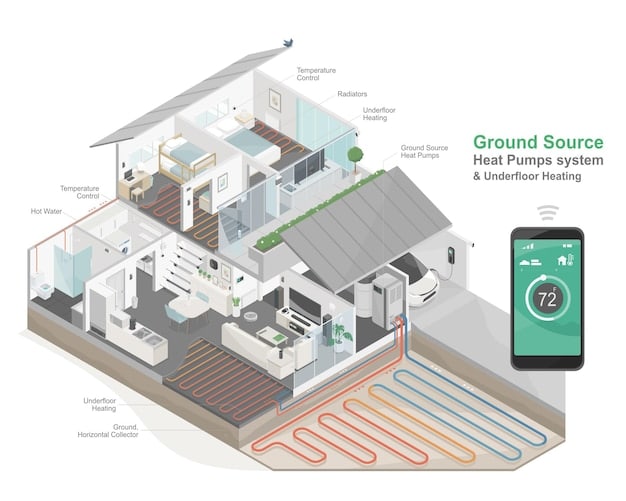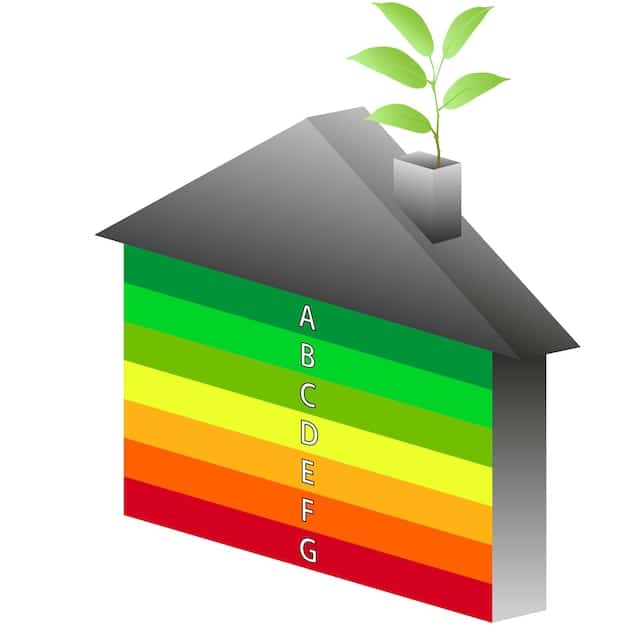Geothermal Energy for Home Heating & Cooling in 2025: A US Guide

Geothermal energy harnesses the Earth’s internal heat for efficient and sustainable home heating and cooling, offering a promising solution for US homeowners in 2025 looking to reduce energy costs and environmental impact.
Are you exploring sustainable and cost-effective ways to heat and cool your home in the US? By 2025, geothermal energy is poised to become an increasingly attractive option, tapping into the Earth’s natural heat to provide efficient and environmentally friendly solutions. Let’s dive into how this technology works and what its future holds.
Understanding Geothermal Energy for Home Use
Geothermal energy is derived from the Earth’s internal heat, a virtually inexhaustible resource. Unlike solar or wind energy, it’s consistent and available 24/7, making it a reliable option for home heating and cooling. This section will explore the basics of geothermal systems and their benefits.
How Geothermal Systems Work
Geothermal systems, also known as ground source heat pumps (GSHPs), utilize the stable temperature of the Earth to regulate the temperature inside your home. They circulate a fluid through underground pipes to either extract heat from the Earth in the winter or dissipate heat into the Earth in the summer.
Key Components of a Geothermal System
A typical geothermal system includes a ground loop (a network of underground pipes), a heat pump, and a distribution system (ductwork or radiant floor heating). The heat pump transfers heat between the ground loop and your home, while the distribution system delivers the conditioned air or water throughout your house.
- Ground Loop: Buried pipes that circulate a heat-transfer fluid.
- Heat Pump: Transfers heat between the ground and the home.
- Distribution System: Delivers heated or cooled air/water.
- Control System: Manages the system’s operation for optimal efficiency.

Geothermal systems offer numerous advantages, including reduced energy bills, lower carbon footprint, and increased comfort. They also have a longer lifespan compared to traditional heating and cooling systems, making them a worthwhile investment for homeowners.
Benefits of Geothermal Heating and Cooling in 2025
By 2025, geothermal energy is expected to become even more appealing due to advancements in technology and increased environmental awareness. This section highlights the key benefits of adopting geothermal systems for home heating and cooling.
Cost Savings
One of the most significant advantages of geothermal systems is their ability to reduce energy bills. Because they use the Earth’s constant temperature, they are much more efficient than traditional systems, resulting in lower operating costs.
Environmental Impact
Geothermal energy is a clean, renewable energy source that produces little to no emissions. By switching to a geothermal system, homeowners can significantly reduce their carbon footprint and contribute to a more sustainable future.
- Reduced energy bills due to high efficiency.
- Lower carbon footprint and environmental impact.
- Increased home comfort with consistent temperatures.
- Longer system lifespan compared to conventional systems.
Furthermore, government incentives and rebates are expected to become more widespread by 2025, making geothermal systems even more financially attractive for US homeowners. These incentives can help offset the initial installation costs and further enhance the long-term savings.
Factors Influencing Geothermal Adoption in the US by 2025
Several factors will influence the adoption of geothermal energy in the US by 2025. These include technological advancements, government policies, and consumer awareness. Understanding these factors is crucial to predicting the future of geothermal home heating and cooling.
Technological Advancements
Ongoing research and development are leading to more efficient and cost-effective geothermal systems. Innovations in drilling techniques, heat pump technology, and ground loop design are making geothermal energy more accessible to a wider range of homeowners.
Government Policies and Incentives
Government policies play a significant role in promoting the adoption of renewable energy sources like geothermal. Tax credits, rebates, and grants can help reduce the upfront costs and make geothermal systems more affordable.
- Advancements in drilling and heat pump technology.
- Supportive government policies and financial incentives.
- Growing consumer awareness of environmental benefits.
- Increasing energy costs making geothermal more competitive.

Consumer awareness and education are also vital. As more homeowners become aware of the environmental and economic benefits of geothermal energy, demand is likely to increase, driving further adoption.
Installation Process and Considerations for Geothermal Systems
Installing a geothermal system requires careful planning and execution. Understanding the installation process and considerations is essential for homeowners considering this technology. This section will walk you through the key steps and factors to keep in mind.
Site Assessment
The first step in installing a geothermal system is a site assessment to determine the suitability of your property. Factors such as soil type, available space, and existing ductwork will influence the design and cost of the installation.
Ground Loop Installation
The ground loop can be installed in several ways, including horizontal loops, vertical loops, and pond loops. The best option depends on the characteristics of your property and the available space.
- Site assessment to evaluate property suitability.
- Ground loop installation based on site conditions.
- Heat pump installation and system integration.
- Professional maintenance for optimal performance.
After the ground loop is installed, the heat pump is connected and integrated with your home’s distribution system. Proper installation and maintenance are crucial for ensuring optimal performance and longevity of the system.
Geothermal Energy: Overcoming Challenges and Future Trends
While geothermal energy offers numerous benefits, it also faces certain challenges. Addressing these challenges and staying informed about future trends is crucial for realizing the full potential of geothermal home heating and cooling.
Initial Costs
The upfront costs of installing a geothermal system can be higher than traditional HVAC systems. However, these costs are often offset by long-term energy savings and government incentives.
Public Awareness and Education
Lack of awareness and understanding of geothermal technology can hinder its adoption. Education and outreach programs are needed to inform homeowners about the benefits and dispel common misconceptions.
- Reducing initial installation costs through incentives.
- Raising public awareness and understanding.
- Developing advanced, efficient geothermal technologies.
- Integrating geothermal with other renewable sources.
Future trends in geothermal energy include the development of more efficient heat pumps, advanced drilling techniques, and integration with other renewable energy sources like solar power. These advancements will further enhance the appeal and accessibility of geothermal systems for home heating and cooling in the US by 2025.
Making the Switch: Is Geothermal Right for Your Home in 2025?
Deciding whether to switch to geothermal energy depends on your specific needs and circumstances. Evaluating the potential benefits and costs is essential for making an informed decision. Consider these factors to determine if geothermal heating and cooling is right for you.
Assess Your Energy Needs
Evaluate your current energy consumption and heating/cooling costs to determine how much you could save with a geothermal system. Consider the size of your home, climate, and energy usage habits.
Explore Available Incentives
Research government incentives and rebates in your area to see how much financial assistance is available. These incentives can significantly reduce the upfront costs of installing a geothermal system.
- Evaluate your energy needs and potential savings.
- Research available government incentives and rebates.
- Consult with qualified geothermal installers.
- Consider long-term benefits and environmental impact.
Consulting with qualified geothermal installers is also crucial. They can assess your property, provide a detailed cost estimate, and help you choose the right system for your needs. By carefully considering these factors, you can make an informed decision about whether geothermal energy is the right choice for your home in 2025.
| Key Point | Brief Description |
|---|---|
| 🔥 Efficiency | Geothermal systems offer high energy efficiency for home heating and cooling. |
| 💰 Cost Savings | Lower energy bills and potential government incentives make it cost-effective. |
| 🌱 Eco-Friendly | Reduces carbon footprint and supports sustainable energy use. |
| 🛠️ Installation | Requires professional assessment and proper installation for optimal performance. |
Frequently Asked Questions About Geothermal Energy
▼
Geothermal energy is heat derived from the Earth’s interior. It’s a renewable resource as the Earth continuously produces heat. This heat can be harnessed for various uses, including heating and cooling homes.
▼
A geothermal heat pump circulates fluid through underground pipes. In winter, it extracts heat from the Earth, while in summer, it transfers heat back into the ground, providing efficient heating and cooling.
▼
The primary benefits include reduced energy bills, lower carbon footprint, increased comfort due to consistent temperatures, and a longer lifespan compared to traditional heating and cooling systems.
▼
The installation cost varies based on factors such as the size of your home, soil conditions, and the type of ground loop installed. However, government incentives can significantly lower the upfront expense.
▼
Yes, geothermal energy is suitable for all climates. Because it utilizes the Earth’s consistent temperature, it can provide efficient heating and cooling regardless of external weather conditions.
Conclusion
As we approach 2025, geothermal energy stands out as a compelling solution for US homeowners seeking sustainable, efficient, and cost-effective ways to heat and cool their homes. By understanding its benefits, overcoming challenges, and staying informed about the latest trends, you can make an informed decision about harnessing the Earth’s power for a more comfortable and environmentally friendly future





